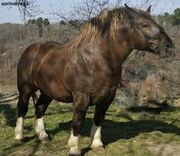No edit summary Tag: rte-wysiwyg |
No edit summary Tag: sourceedit |
||
| Line 1: | Line 1: | ||
| − | <p style="text-align:center;">[[File:Murakoz-Horse.jpg|thumb]]The '''Muraközi''' is a |
+ | <p style="text-align:center;">[[File:Murakoz-Horse.jpg|thumb]]The '''Muraközi''' is a breed of [[horse]] that was developed in Muraköz along the River Mura in Southern Hungary. It was used extensively after World War I for arable farming, and even plowing.</p> |
==History== |
==History== |
||
Revision as of 18:24, 15 July 2017

The Muraközi is a breed of horse that was developed in Muraköz along the River Mura in Southern Hungary. It was used extensively after World War I for arable farming, and even plowing.
History
World War I
Muraközi horses were used after World War I for arable farming. Arable farming increased in Southern and Eastern Europe. The breed was in great demand; therefore, the breed flourished. In the mid-1920s Muraközi horses made up 20% of the horse population in Hungary. In the 1970s 80-85% of the horses were still employed for farming. This was really 231,000 in all.
World War II
By the end of World War II, the breeding stock depleted. At this time outside blood was introduced. This encouraged the regrowth of arable farming. From 1947-1949, 17 stallions of the Ardennais breed were imported from France, and 59 from Belgium. This reestablished the breed in a short time.
Breeding
The breeding of this horse was centered in Muraköz. The foundation stock was sometimes referred to as Mur-Insulan. Arabian horses were used very much in Hungarian horse breeding. When the Arabian was introduced to this breed, the offspring became lighter. This gave the breed greater freedom of action.
After the lighter offspring, good-quality stallions were used. Percherons and Ardennais horses were imported from Belgium. This produced a more or less fixed type of quick omoving and alert horse. The Muraközi breed became ideal for farm work. They could even plow on heavy soils.
Muraközi horses are bred in Poland, the former countries of Yugoslavia, and in Hungary.
Characteristics
This breed is classified as cold-blooded. Like the Boulonnais and Breton breeds, the Muraközi breed is very distinctive as a result of the Arabian influence.
There are two types of the Muraközi. One is a heavy horse that stands 16 hands high or more. The second is a lighter, more active, and general type of horse.
The color of this breed is usually a chestnut coat with a flaxen mane and tail. Although, bays, blacks, and grays can also occur.
The head is plain and honest in outlook. One notable feature is its large kind eyes.
Muraközi horses have a compact and very powerful physical structure. There is much depth through the girth. Its legs have little feathering, and it is short but strong. The horse's tail is set low, and the hind quarters are very round and muscled.
These horses usually mature early on in life, and may be worked when only 2 years old. Their temperament is calm and even.
Perhaps the most notable characteristic of all is their ability to convert food into energy very efficiently. This makes it economical to keep.
